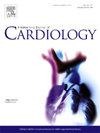Early catheter ablation versus conservative- only management in patients with electrical storm. Systematic review and meta- analysis
IF 3.2
2区 医学
Q2 CARDIAC & CARDIOVASCULAR SYSTEMS
引用次数: 0
Abstract
Background
Electrical storm (ES) is a life- threatening condition. Both recurrence and mortality rates remain unacceptably high. Current guidelines recommend initial conservative approach using anti-arrhythmic drugs (AADs), followed by catheter ablation (CA) for those with refractory ES.
Methods
We searched PubMed and Scopus for articles comparing an initial conservative approach - based on AADs/ sedation- with an early referral for CA approach. The primary endpoint was long term mortality, while secondary endpoints included ES recurrence and the incidence of ventricular arrhythmias (VAs)/ defibrillator shocks during the follow- up.
Results
Seven studies, primarily observational cohorts, were analyzed. The pooled population (999 patients) consisted mostly of males with ischemic cardiomyopathy, presenting with ventricular tachycardias (VTs). The mean left ventricular ejection fraction was 35.5 % (9.5 %). 493 patients were treated with CA during the index hospitalization. Early CA was associated with significantly lower long- term mortality (OR: 0.44, 95 %CI: 0.31–0.63). Additionally, it was associated with lower rates of both ES recurrence and VAs/ shocks during the follow- up (OR: 0.27, 95 %CI: 0.15–0.48 and OR: 0.33, 95 %CI: 0.21–0.52, respectively).
Conclusions
Meta- analysis of primarily observational studies revealed that early referral of ES patients for CA may improve their prognosis. The invasive approach was associated with lower mortality and reduced recurrence rates of major arrhythmic events. Although some inherent limitations affect the strength of these findings, they remain promising. They highlight the need for further research on the topic, as their confirmation in randomized trials could lead to a shift in the standard of care of ES patients.

电风暴患者早期导管消融与单纯保守治疗的比较。系统回顾和荟萃分析。
背景:电风暴(ES)是一种危及生命的疾病。复发率和死亡率仍然高得令人无法接受。目前的指南建议对难治性ES患者采用抗心律失常药物(AADs)初始保守治疗,然后进行导管消融(CA)。方法:我们在PubMed和Scopus中检索了比较初始保守入路(基于AADs/镇静)和早期转诊CA入路的文章。主要终点是长期死亡率,而次要终点包括随访期间ES复发和室性心律失常(VAs)/除颤器电击的发生率。结果:分析了7项研究,主要是观察性队列。合并人群(999例患者)主要由患有缺血性心肌病的男性组成,表现为室性心动过速(vt)。平均左室射血分数为35.5% %(9.5% %)。493例患者在指数住院期间接受了CA治疗。早期CA与较低的长期死亡率相关(OR: 0.44, 95 %CI: 0.31-0.63)。此外,在随访期间,它与较低的ES复发率和VAs/冲击率相关(分别为OR: 0.27, 95 %CI: 0.15-0.48和OR: 0.33, 95 %CI: 0.21-0.52)。结论:主要观察性研究的荟萃分析显示,早期转诊ES患者的CA可能改善其预后。有创入路与较低的死亡率和降低主要心律失常事件的复发率相关。尽管一些固有的限制影响了这些发现的强度,但它们仍然是有希望的。他们强调需要对该主题进行进一步研究,因为他们在随机试验中的证实可能会导致ES患者护理标准的转变。
本文章由计算机程序翻译,如有差异,请以英文原文为准。
求助全文
约1分钟内获得全文
求助全文
来源期刊

International journal of cardiology
医学-心血管系统
CiteScore
6.80
自引率
5.70%
发文量
758
审稿时长
44 days
期刊介绍:
The International Journal of Cardiology is devoted to cardiology in the broadest sense. Both basic research and clinical papers can be submitted. The journal serves the interest of both practicing clinicians and researchers.
In addition to original papers, we are launching a range of new manuscript types, including Consensus and Position Papers, Systematic Reviews, Meta-analyses, and Short communications. Case reports are no longer acceptable. Controversial techniques, issues on health policy and social medicine are discussed and serve as useful tools for encouraging debate.
 求助内容:
求助内容: 应助结果提醒方式:
应助结果提醒方式:


